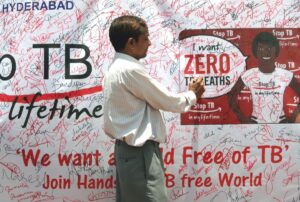 Tuberculosis (TB) in India continues to be a major public health burden, even as cases have decreased. This is according to the latest World Health Organization (WHO) report on TB, launched earlier this week, which provides an overview of how the world is tackling one of its dominant infectious disease challenges.
Tuberculosis (TB) in India continues to be a major public health burden, even as cases have decreased. This is according to the latest World Health Organization (WHO) report on TB, launched earlier this week, which provides an overview of how the world is tackling one of its dominant infectious disease challenges.
The news is not good: the world is not on track to achieve global TB targets by 2020, missing a target of achieving a twenty percent reduction in cases between 2015 and 2018. “The global decline in the total number of TB deaths between 2015 and 2018 was eleven percent, less than one-third of the way towards the End TB Strategy milestone of 35 percent decrease by 2020,” the WHO said.
This is not to say that there are fewer TB cases and deaths. 1.5 million worldwide died from TB in 2018, compared to 1.6 million deaths the preceding year. This decrease is attributed by the WHO to seven million more people availing TB treatment in 2018 – an increase from 6.4 million the previous year. However, three million people continue to miss out on treatment, presenting an obstacle towards achieving global targets.
India is the primary driver of TB worldwide, accounting for 27 percent of cases – more than any other country. China, accounting for fourteen percent, ranks a distant second. 2.69 million cases of TB in India were reported in 2018.
Of these, 5.4 lakh went unnotified to the WHO. The issue of notification of TB cases has been a long-standing issue in India. The 2016 report, for example, was forced to adjust the WHO’s estimate of the global TB burden due to new data from India and other countries such as Indonesia. The issue of underreporting continues, but has improved according to the report. India’s notification of TB cases increased by sixty percent between 2013 and 2018, from 1.2 million in the former to two million in the latter.
Nonetheless, there is still a sizeable gap between the seven million TB cases notified and the ten million TB cases there are estimated to be in actuality. India is the leader in this regard, accounting for 25 percent of the chasm.
HIV-associated TB continues to be a significant public health burden in India, with 49,047 TB patients also being HIV-positive. Of these, ninety percent receive antiretroviral therapy. India accounts for nine percent of the global burden of HIV-associated TB, which results in 11,000 deaths annually.

Yet the report does contain some positive news from India. “The latest treatment outcome data for new cases of TB show a global treatment success rate of 85 percent in 2017, an increase from 81 percent in 2016,” the report says. “The improvement was mainly due to progress in India.” The country has a treatment success rate of 81 percent. The domestic budget for TB in India quadrupled between 2016 and 2019, with a current budget of US$583 billion – 77 percent of which came from domestic sources (the remainder came from international donor sources). Nonetheless, there are improvements which are much-needed, concerning treatment in particular – particularly when it comes to drug resistance.
The TB treatment rate in India is just 74 percent according to the WHO. Fifty percent of Indian TB patients are tested with rapid diagnostics at the time of diagnosis.
Drug resistance is a major challenge in the fight against TB, with the potential to render frontline treatments and even second-line treatments virtually useless. Drug resistance is arguably the largest threat to Prime Minister Narendra Modi’s target of ridding India of TB by 2025, with a high burden of cases of TB resistant to the antibiotic rifampicin. In India in 2018, there were 58,347 laboratory-confirmed cases of multidrug-resistant and rifampicin-resistant TB (MDR/RR-TB) and 3,400 cases of extra-drug-resistant TB (XDR-TB).
There is a significant treatment gap concerning drug-resistant strains of TB. “Ten countries accounted for 75 percent of the global gap between treatment enrolments and the estimated number of new cases of MDR/RR-TB in 2018, and thus will have a strong influence on progress in closing this gap,” the report says. India is one of those countries: in fact, together with China, it accounts for 43 percent of the gap. Of the 58,347 cases of MDR/RR-TB in India in 2018, 46,569 began treatment and 38,236 were tested for resistance to second-line treatment.

“Sustained progress on TB will require strong health systems and better access to services,” said WHO Director-General Dr Tedros Adhanom Ghebreyesus. “That means a renewed investment in primary health care and a commitment to universal health coverage.”
The onus is upon India and other high-burden countries to show leadership. Responding to the WHO report, scientific director of the International Union Against Tuberculosis and Lung Disease Dr Paula I. Fujiwara observed “the number of people with TB in India is falling and that is good news. This demonstrates that making serious gains against TB in a short time frame is possible even in the world’s largest and most geographically diverse countries if political leaders prioritise the disease.
“But let’s be honest — TB is not still not falling nearly fast enough in India, progress is still too slow to meet the targets – and if we don’t end TB in India we can’t hope to end TB globally.”
The Global Tuberculosis Report can be accessed here. The country profile for India can be accessed here.


Ya TB is most dangerous disease and making effect on many people in india and world.